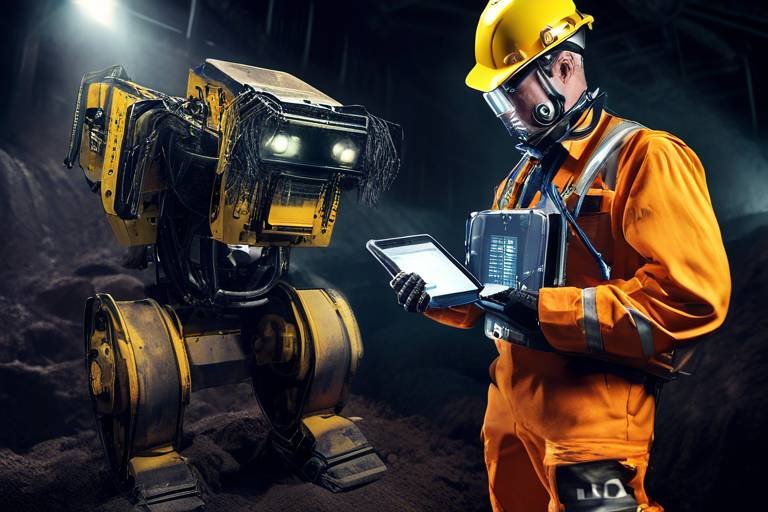The Role of AI in Enhancing Supply Chain Analytics
In today’s fast-paced world, where every second counts, businesses are constantly on the lookout for ways to improve their operations. Enter artificial intelligence (AI), the game changer that is revolutionizing supply chain analytics. AI isn’t just a buzzword; it’s a powerful tool that enhances efficiency, boosts decision-making capabilities, and ultimately drives performance in logistics and operations management. Imagine having a crystal ball that not only predicts the future but also optimizes your resources to meet that future head-on. That’s what AI brings to the table!
At its core, AI transforms the way data is processed and analyzed, allowing companies to gain insights that were previously unimaginable. It’s like having a supercharged assistant who can sift through mountains of data in the blink of an eye, identifying patterns and trends that can lead to smarter, faster decisions. In a landscape where every decision can impact the bottom line, AI provides businesses with the edge they need to stay competitive.
So, how exactly does AI enhance supply chain analytics? Well, let’s break it down. First, we have machine learning, which allows systems to learn from data and improve over time without being explicitly programmed. This means that the more data you feed it, the smarter it gets! Then there’s predictive analytics, which uses historical data to forecast future trends—think of it as having an educated guess based on solid evidence. Lastly, we have automation, which streamlines processes and reduces human error, allowing for a smoother operation overall.
As we delve deeper into the various AI technologies and their applications in supply chain analytics, it becomes clear that the integration of AI is not just an option but a necessity for businesses aiming to thrive in today’s competitive market. From optimizing inventory levels to predicting maintenance needs, AI is the backbone of modern supply chain strategies. It’s not just about keeping up; it’s about staying ahead of the curve.
In the sections that follow, we will explore the specific AI technologies that are reshaping supply chain analytics, the benefits they offer, and how they can be leveraged for maximum impact. Buckle up, because the journey through the world of AI in supply chain analytics is just getting started!
- What is supply chain analytics? Supply chain analytics involves the collection and analysis of data to improve operational efficiency and decision-making within the supply chain.
- How does AI improve supply chain analytics? AI improves supply chain analytics by providing advanced data processing capabilities, predictive insights, and automation that streamline operations.
- What are the key benefits of using AI in supply chain management? The key benefits include enhanced efficiency, cost reduction, improved decision-making, and the ability to predict future trends.
- Can AI help with demand forecasting? Absolutely! AI enhances demand forecasting accuracy by analyzing historical data and identifying patterns that inform better inventory management.

Understanding Supply Chain Analytics
Supply chain analytics is a powerful tool that involves the collection and analysis of data to enhance operational efficiency. Think of it as the compass guiding a ship through turbulent waters; without it, businesses can easily lose their way. At its core, supply chain analytics helps organizations make sense of vast amounts of data generated at every stage of the supply chain, from sourcing raw materials to delivering finished products. By leveraging analytics, companies can identify trends, forecast demand, and optimize their operations, ultimately leading to a more agile and responsive supply chain.
The importance of analytics in supply chain management cannot be overstated. In today's fast-paced market, where consumer preferences shift like sand dunes, businesses need to be equipped with real-time insights to make informed decisions. For instance, consider a retailer who can analyze customer purchasing patterns. By understanding which products are flying off the shelves and which are gathering dust, they can adjust their inventory levels accordingly, ensuring they meet customer demand without overstocking.
Moreover, analytics can help organizations uncover inefficiencies in their supply chain processes. For example, a manufacturer might discover that a particular supplier consistently delivers materials late, causing production delays. By analyzing this data, they can either work with the supplier to improve their performance or seek alternative sources. This proactive approach not only saves time and money but also enhances overall customer satisfaction.
To truly grasp the impact of supply chain analytics, it's essential to understand its key components:
- Data Collection: Gathering data from various sources, including suppliers, logistics partners, and internal systems.
- Data Analysis: Using statistical methods and algorithms to interpret the data and extract meaningful insights.
- Reporting: Presenting the analyzed data in a way that stakeholders can easily understand and act upon.
In summary, supply chain analytics is not just a trend; it's a necessity for modern businesses looking to thrive in a competitive landscape. By embracing analytics, companies can transform their operations, enhance efficiency, and ultimately deliver better value to their customers.

AI Technologies in Supply Chain
Artificial Intelligence (AI) is not just a buzzword; it’s a game-changer in the realm of supply chain analytics. When we talk about AI technologies in supply chain management, we are diving into a world where machine learning, predictive analytics, and automation come together to create a seamless flow of information and enhance decision-making processes. Imagine a vast ocean of data—AI acts like a powerful ship navigating through this ocean, helping businesses understand the currents and tides of their operations.
One of the most significant impacts of AI in supply chain analytics is through machine learning. This technology allows systems to learn from historical data, identifying patterns and trends that humans might overlook. For instance, machine learning algorithms analyze sales data, customer behavior, and seasonal variations to forecast demand accurately. By doing so, businesses can optimize their inventory levels, ensuring that they have the right products available at the right time, which ultimately leads to increased customer satisfaction and reduced costs.
In addition to machine learning, predictive analytics plays a crucial role in enhancing supply chain efficiency. This technology takes data analysis a step further by not only identifying trends but also predicting future outcomes. For example, predictive analytics can forecast potential disruptions in the supply chain, such as delays due to weather or supplier issues. By anticipating these challenges, companies can proactively adjust their logistics strategies, minimizing downtime and keeping operations running smoothly.
Moreover, the automation of supply chain processes is another area where AI shines. Automation reduces the reliance on human intervention, which can often lead to errors and inefficiencies. With AI-driven automation, tasks such as order processing, inventory management, and even transportation logistics can be streamlined. This not only speeds up operations but also frees up human resources for more strategic tasks. Picture a warehouse where robots handle the picking and packing of items while humans focus on optimizing supply chain strategies—this is the future AI is paving the way for.
To illustrate the impact of these technologies, consider the following table that summarizes the key AI technologies and their applications in supply chain management:
| AI Technology | Application |
|---|---|
| Machine Learning | Demand forecasting and inventory optimization |
| Predictive Analytics | Forecasting disruptions and optimizing logistics |
| Automation | Streamlining order processing and inventory management |
In conclusion, the integration of AI technologies into supply chain analytics is not just about adopting new tools; it’s about transforming the way businesses operate. By leveraging machine learning, predictive analytics, and automation, companies can enhance their efficiency, reduce costs, and make informed decisions that drive success. The future of supply chain management is undoubtedly intertwined with AI, and those who embrace these technologies will find themselves at the forefront of innovation.

Machine Learning Applications
Machine learning is like having a super-smart assistant that never sleeps. It tirelessly analyzes vast amounts of historical data, identifying patterns and trends that humans might overlook. This capability is particularly beneficial in the realm of supply chain management, where understanding past behaviors can lead to more informed future decisions. Imagine trying to predict the weather without any data—it's nearly impossible! Similarly, without machine learning, forecasting demand and optimizing inventory levels becomes a shot in the dark.
One of the most impressive applications of machine learning in supply chain analytics is demand forecasting. By examining past sales data, seasonal trends, and even external factors like economic indicators, machine learning algorithms can generate predictions that are not only accurate but also actionable. For instance, if a retailer notices a spike in sales of winter coats during a particular month, machine learning can help predict similar trends for the upcoming years, allowing businesses to stock up appropriately. This proactive approach can significantly reduce instances of overstock or stockouts, which can cost companies dearly.
Another noteworthy application is in inventory optimization. Machine learning algorithms can analyze various factors, such as sales velocity, lead times, and supplier reliability, to determine the optimal inventory levels for various products. This process is akin to balancing on a seesaw; too much inventory on one side can lead to waste and increased holding costs, while too little can result in missed sales opportunities. By leveraging machine learning, companies can find that perfect balance, ensuring they have just the right amount of stock to meet customer demand without incurring unnecessary costs.
Additionally, machine learning can enhance predictive maintenance in supply chains. By analyzing data from machinery and equipment, these algorithms can predict when a piece of equipment is likely to fail. This foresight allows businesses to perform maintenance before a breakdown occurs, which can drastically reduce downtime. Imagine a delivery truck breaking down in the middle of a crucial delivery; the costs associated with that kind of disruption can be staggering. With machine learning, companies can avoid such scenarios, keeping their operations running smoothly.
In summary, the applications of machine learning in supply chain analytics are vast and varied. From improving demand forecasting to optimizing inventory and enabling predictive maintenance, machine learning serves as a powerful tool that can transform how businesses operate. As we continue to embrace technology, the integration of machine learning into supply chain processes will undoubtedly lead to smarter, more efficient operations.
- What is machine learning in supply chain analytics?
Machine learning in supply chain analytics refers to the use of algorithms that analyze historical data to identify patterns, enabling better forecasting and optimization of various supply chain processes.
- How does machine learning improve demand forecasting?
By analyzing past sales data and external factors, machine learning algorithms can generate accurate predictions about future demand, allowing businesses to stock appropriately and reduce waste.
- What is predictive maintenance?
Predictive maintenance uses machine learning to analyze data from equipment to anticipate failures before they occur, helping businesses reduce downtime and maintenance costs.

Predictive Maintenance
Predictive maintenance is a game changer in the realm of supply chain management. Imagine being able to foresee equipment failures before they disrupt your operations. Sounds like something out of a sci-fi movie, right? Well, thanks to artificial intelligence (AI), this is now a reality. By utilizing advanced algorithms and data analytics, businesses can monitor the health of their machinery in real-time, allowing them to anticipate issues before they escalate into costly downtime.
At its core, predictive maintenance leverages historical data and machine learning to identify patterns that indicate potential failures. For example, if a particular machine has a history of overheating after a certain number of operational hours, AI can flag this as a risk and alert maintenance teams to perform checks before any actual failure occurs. This proactive approach not only enhances operational efficiency but also significantly reduces repair costs and extends the lifespan of equipment.
Consider this: a manufacturing plant that implements predictive maintenance can save thousands of dollars each month by avoiding unplanned shutdowns. In a typical scenario, an unanticipated machine failure could lead to a halt in production, which not only affects the bottom line but also impacts customer satisfaction due to delayed deliveries. By predicting when a machine is likely to fail, companies can schedule maintenance during off-peak hours, ensuring that production remains uninterrupted.
Moreover, the data collected from predictive maintenance can be invaluable for continuous improvement. Companies can analyze the reasons behind equipment failures and refine their maintenance strategies accordingly. This leads to better resource allocation, as maintenance teams can focus on the most critical equipment instead of performing routine checks on machines that are functioning well.
To illustrate the impact of predictive maintenance, let’s look at a simple table comparing traditional maintenance approaches with predictive maintenance:
| Aspect | Traditional Maintenance | Predictive Maintenance |
|---|---|---|
| Approach | Reactive (fix after failure) | Proactive (predict and prevent) |
| Downtime | High | Low |
| Cost | Higher due to emergency repairs | Lower through scheduled maintenance |
| Equipment Lifespan | Shorter due to neglect | Extended through timely interventions |
In conclusion, predictive maintenance is not just a buzzword; it's a crucial strategy that can significantly enhance the efficiency and reliability of supply chains. By adopting AI-driven predictive maintenance, companies can not only protect their assets but also gain a competitive edge in the market. After all, in today’s fast-paced business environment, staying ahead of potential issues is key to success.
- What is predictive maintenance? Predictive maintenance is an approach that uses AI and data analytics to predict equipment failures before they occur, allowing for timely maintenance and reduced downtime.
- How does predictive maintenance save costs? By preventing unexpected breakdowns and optimizing maintenance schedules, predictive maintenance significantly lowers repair costs and minimizes production interruptions.
- What technologies are used in predictive maintenance? Technologies include machine learning algorithms, IoT sensors, and data analytics tools that monitor equipment conditions in real-time.
- Can predictive maintenance be applied to all types of equipment? Yes, predictive maintenance can be applied to various equipment types across different industries, including manufacturing, logistics, and transportation.

Demand Forecasting
Accurate is the backbone of effective supply chain management. Imagine trying to hit a target blindfolded; that’s what managing supply chains feels like without reliable forecasts. With the rapid changes in market conditions and consumer preferences, businesses often find themselves scrambling to keep up. This is where artificial intelligence shines, transforming the way companies predict future demand.
AI enhances demand forecasting by leveraging vast amounts of historical data, identifying patterns, and providing insights that would be nearly impossible for humans to discern alone. For instance, machine learning algorithms can analyze previous sales data, seasonal trends, and even external factors like economic indicators or social media sentiment. This capability allows businesses to anticipate shifts in demand with remarkable accuracy.
Let’s break down how AI improves demand forecasting:
- Data Integration: AI systems can pull data from various sources, including sales records, inventory levels, and market trends, creating a comprehensive view of demand.
- Real-Time Analysis: Unlike traditional methods, AI-driven forecasts can adapt in real-time, responding to sudden changes in consumer behavior or market conditions.
- Predictive Analytics: By using algorithms that learn from past data, businesses can make informed predictions about future sales, helping them to adjust their supply chain strategies accordingly.
For example, consider a retail company preparing for the holiday season. By analyzing historical sales data from previous years, along with current market trends, AI can predict which products will be in high demand. This allows the company to optimize inventory levels, ensuring they have enough stock on hand to meet customer needs without overstocking items that won’t sell.
Additionally, AI-driven demand forecasting can help in reducing waste. When companies accurately predict demand, they can minimize excess inventory, which not only saves money but also reduces the environmental impact of unsold products. It’s a win-win situation!
In conclusion, demand forecasting powered by AI is not just about predicting numbers; it’s about making strategic decisions that enhance operational efficiency and customer satisfaction. By utilizing advanced analytics, businesses can stay ahead of the curve, ensuring they are prepared for whatever the market throws their way.
- What is demand forecasting? Demand forecasting is the process of predicting future customer demand for a product or service based on historical data and market analysis.
- How does AI improve demand forecasting? AI improves demand forecasting by analyzing large datasets, identifying trends, and providing real-time insights that help businesses make informed decisions.
- What are the benefits of accurate demand forecasting? Accurate demand forecasting leads to better inventory management, reduced waste, improved customer satisfaction, and enhanced overall efficiency in supply chain operations.

Automation in Supply Chain Processes
In today's fast-paced business landscape, automation has become a game-changer in supply chain processes. Imagine a world where mundane and repetitive tasks are handled by intelligent systems, allowing human workers to focus on strategic decision-making and creative problem-solving. That's the power of AI-driven automation! By integrating advanced technologies into supply chain operations, companies can streamline workflows, enhance productivity, and significantly reduce the likelihood of human error.
One of the most exciting aspects of automation in supply chains is its ability to transform logistics. For instance, automated systems can manage inventory levels in real-time, ensuring that stock is replenished just when it's needed. This not only prevents overstocking but also minimizes the risk of stockouts, which can be detrimental to customer satisfaction. With AI algorithms analyzing historical data and predicting demand trends, companies can optimize their inventory management strategies like never before.
Moreover, automation extends beyond inventory management. In warehousing, automated guided vehicles (AGVs) and robotic systems are revolutionizing how goods are stored and retrieved. These technologies can operate 24/7, drastically reducing the time it takes to move products from one point to another. This means faster order fulfillment and a more agile response to market demands. As a result, businesses can maintain a competitive edge by delivering products to customers more quickly and efficiently.
In the realm of distribution, automation plays a crucial role in optimizing delivery routes. AI systems can analyze traffic patterns, weather conditions, and other variables to determine the most efficient paths for transportation. This not only saves time but also reduces fuel consumption, leading to lower operational costs. The combination of speed and efficiency is akin to having a well-oiled machine, where every cog works in harmony to achieve a common goal.
However, it's essential to recognize that automation doesn't mean the end of human involvement in supply chains. Instead, it complements human skills. Employees can take on more value-added tasks, such as strategic planning and relationship management, while AI handles the heavy lifting of data processing and routine operations. This synergy between human intelligence and machine efficiency is what truly drives innovation in supply chains.
As we look to the future, the potential of automation in supply chain processes is boundless. Companies that embrace these technologies will not only enhance their operational efficiency but also position themselves as leaders in their respective industries. In a world where customer expectations are continually rising, automation provides the tools necessary to meet and exceed those demands.
- What is supply chain automation? - Supply chain automation refers to the use of technology to streamline and optimize various supply chain processes, reducing the need for manual intervention.
- How does AI improve supply chain automation? - AI enhances automation by analyzing data and making real-time decisions that optimize inventory management, logistics, and distribution.
- What are the benefits of automating supply chain processes? - Benefits include increased efficiency, reduced operational costs, improved accuracy, and enhanced customer satisfaction.
- Can automation replace human jobs in supply chains? - While automation can take over repetitive tasks, it allows humans to focus on more strategic roles, ultimately leading to a more skilled workforce.

Benefits of AI in Supply Chain Analytics
Integrating artificial intelligence (AI) into supply chain analytics is like adding rocket fuel to a car—it significantly boosts performance and efficiency. By leveraging AI technologies, businesses can transform their operations, making them more agile and responsive to market demands. One of the most compelling benefits of AI is its ability to enhance efficiency across the board. Imagine a world where data is processed in real-time, allowing companies to make informed decisions at lightning speed. This is not just a dream; it’s the reality that AI brings to the table.
Furthermore, AI-driven analytics can lead to substantial cost reductions. By optimizing processes and minimizing waste, companies can allocate resources more effectively. For instance, AI can analyze historical data to pinpoint inefficiencies in the supply chain, enabling managers to take corrective actions before issues escalate. This proactive approach not only saves money but also enhances overall operational performance.
Another significant advantage is the enhanced decision-making capabilities that AI provides. With access to real-time data and predictive analytics, supply chain managers can make decisions based on solid evidence rather than gut feelings. This shift towards data-driven decision-making means that companies can adapt quickly to changes in demand, supplier issues, or market trends. For example, if a sudden spike in demand for a product is detected, AI can alert managers to adjust inventory levels accordingly, preventing stockouts and lost sales.
In addition to these benefits, AI can also improve customer satisfaction. By ensuring that products are available when customers want them, companies can enhance their reputation and build loyalty. Imagine a scenario where a customer places an order online, and thanks to AI, the system automatically predicts the best distribution center to fulfill that order quickly. This not only speeds up delivery times but also minimizes shipping costs, creating a win-win situation for both the business and the customer.
| Benefit | Description |
|---|---|
| Improved Efficiency | AI processes data in real-time, allowing for quicker decision-making and streamlined operations. |
| Cost Reduction | Optimizes resource allocation and minimizes waste, leading to significant savings. |
| Enhanced Decision-Making | Provides real-time insights, enabling data-driven decisions that improve outcomes. |
| Customer Satisfaction | Ensures product availability and faster delivery times, enhancing customer loyalty. |
In conclusion, the benefits of integrating AI into supply chain analytics are profound and far-reaching. From boosting efficiency and cutting costs to enhancing decision-making and improving customer satisfaction, AI is revolutionizing how businesses operate. As companies continue to embrace these technologies, those who adapt quickly will undoubtedly gain a competitive edge in the marketplace.
- What is the primary benefit of AI in supply chain analytics?
AI enhances efficiency, reduces costs, and improves decision-making through real-time data analysis. - How does AI improve demand forecasting?
AI analyzes historical data to identify patterns, allowing for more accurate predictions of future demand. - Can AI help reduce operational costs?
Yes, by optimizing resource allocation and minimizing waste, AI can significantly lower operational costs. - What role does automation play in supply chain management?
Automation streamlines processes, reduces human error, and increases overall efficiency in the supply chain.

Cost Reduction Strategies
In today's fast-paced business environment, cost reduction is not just a luxury; it's a necessity. Companies are constantly searching for ways to streamline operations and maximize profits. With the integration of artificial intelligence (AI) into supply chain analytics, businesses are discovering innovative strategies to cut costs without sacrificing quality. Imagine trying to navigate a maze blindfolded—AI acts as your guide, helping you find the most efficient path through the complexities of supply chain management.
One of the primary ways AI contributes to cost reduction is through optimized resource allocation. By analyzing vast amounts of data, AI can identify which resources are underutilized and which are overextended. This allows companies to allocate their resources more effectively, ensuring that every dollar spent contributes to the bottom line. For instance, AI algorithms can analyze historical sales data and predict future demand, enabling businesses to adjust their inventory levels accordingly. This not only minimizes excess stock but also reduces the costs associated with storage and handling.
Another significant area where AI shines is in waste minimization. In supply chains, waste can come in many forms, whether it's excess inventory, inefficient transportation routes, or even labor costs. AI tools can analyze operational workflows to pinpoint inefficiencies. For example, by using machine learning algorithms, companies can optimize their logistics routes, ensuring that deliveries are made in the most efficient manner possible. This not only saves fuel costs but also reduces the wear and tear on vehicles, ultimately leading to lower maintenance costs.
Moreover, AI can enhance supplier relationship management, which is crucial for cost reduction. By leveraging data analytics, businesses can evaluate supplier performance and negotiate better terms based on data-driven insights. For example, if AI identifies that a particular supplier consistently delivers late, companies can seek alternatives or negotiate penalties, thereby reducing costs associated with delays. This proactive approach can lead to significant savings over time.
Furthermore, the implementation of predictive analytics plays a pivotal role in cost reduction strategies. By forecasting potential issues before they arise, companies can take preventive measures. For instance, if predictive analytics indicate a potential supply chain disruption due to a natural disaster, businesses can adjust their inventory levels or reroute shipments in advance, thus avoiding costly delays and stockouts. This foresight is invaluable in maintaining smooth operations and minimizing unexpected expenses.
Ultimately, the integration of AI into supply chain analytics not only promotes cost reduction but also fosters a culture of continuous improvement. As companies gather more data and refine their AI models, they can uncover new opportunities for savings and efficiency. In summary, AI serves as a powerful tool in the quest for cost reduction, enabling businesses to navigate the complexities of supply chain management with greater agility and precision.
- How does AI help in reducing supply chain costs?
AI helps by optimizing resource allocation, minimizing waste, and enhancing supplier relationships, ultimately leading to lower operational costs. - What role does predictive analytics play in cost reduction?
Predictive analytics allows companies to foresee potential disruptions, enabling them to take preventive actions to avoid costly delays and stockouts. - Can small businesses benefit from AI in their supply chains?
Absolutely! AI tools can be scaled to fit businesses of all sizes, providing valuable insights that can lead to significant cost savings.

Enhanced Decision-Making
In today's fast-paced business environment, the ability to make informed decisions quickly can be the difference between success and failure. This is where artificial intelligence (AI) comes into play, enhancing decision-making processes in supply chain management like never before. Imagine having a crystal ball that not only predicts future trends but also provides actionable insights based on real-time data. That’s the power of AI!
One of the most significant advantages of AI in decision-making is its capability to analyze vast amounts of data at lightning speed. Traditional methods of decision-making often rely on historical data and gut feelings, which can lead to delays and inaccuracies. In contrast, AI algorithms are designed to sift through complex datasets, identifying patterns and anomalies that human analysts might overlook. This means that businesses can respond to changes in the market, customer preferences, and supply chain disruptions almost instantaneously.
For example, consider a retailer facing fluctuating demand for a popular product. With AI-driven analytics, the retailer can forecast demand with astonishing accuracy by analyzing factors such as seasonality, trends, and even social media sentiment. This predictive capability allows them to adjust inventory levels proactively, ensuring they meet customer demand without overstocking. The result? Increased customer satisfaction and reduced costs associated with excess inventory.
Moreover, AI enhances decision-making through real-time insights. By integrating AI tools into their operations, companies can monitor supply chain performance continuously. This real-time visibility enables managers to make informed decisions on the fly. For instance, if a supplier encounters a delay, AI can quickly analyze the impact on the entire supply chain and suggest alternative suppliers or routes to mitigate disruptions. This agility is crucial in maintaining operational efficiency and competitiveness.
Another fascinating aspect of AI in decision-making is its ability to simulate various scenarios. Using advanced modeling techniques, AI can create simulations that allow decision-makers to explore the potential outcomes of different strategies. For example, if a company is considering entering a new market, AI can model the financial implications, competitive landscape, and potential risks associated with that decision. This level of foresight equips businesses with the knowledge they need to make strategic choices that align with their long-term goals.
To sum it up, the integration of AI into supply chain analytics transforms decision-making from a reactive process into a proactive strategy. By leveraging AI’s capabilities, companies can enjoy:
- Faster decision-making: Real-time data analysis accelerates the decision-making process.
- Improved accuracy: AI reduces human error and enhances forecasting precision.
- Strategic foresight: Scenario simulations provide insights into potential outcomes.
In conclusion, as the landscape of supply chain management continues to evolve, embracing AI for enhanced decision-making is not just an option; it's a necessity. Companies that harness the power of AI will not only streamline their operations but also gain a significant competitive edge in an increasingly complex marketplace.
Q: How does AI improve decision-making in supply chains?
A: AI enhances decision-making by providing real-time insights, analyzing vast datasets for trends, and simulating various scenarios to predict outcomes.
Q: What are the benefits of real-time data analysis?
A: Real-time data analysis allows companies to respond quickly to market changes, optimize inventory levels, and reduce operational costs.
Q: Can AI help in demand forecasting?
A: Yes, AI significantly improves demand forecasting accuracy by analyzing multiple factors, including historical data, market trends, and customer behavior.
Frequently Asked Questions
- What is supply chain analytics?
Supply chain analytics refers to the process of collecting and analyzing data to enhance operational efficiency within the supply chain. By leveraging data, businesses can identify trends, optimize processes, and make informed decisions that improve overall performance.
- How does AI improve supply chain analytics?
AI enhances supply chain analytics by utilizing advanced technologies like machine learning and predictive analytics. These tools allow businesses to process large volumes of data quickly, identify patterns, and generate actionable insights that lead to better decision-making and increased efficiency.
- What are some applications of machine learning in supply chain management?
Machine learning is used in various ways within supply chain management, such as demand forecasting and inventory optimization. By analyzing historical data, machine learning algorithms can predict future demand and help businesses maintain optimal inventory levels, reducing excess stock and minimizing shortages.
- What is predictive maintenance, and why is it important?
Predictive maintenance involves using AI to foresee equipment failures before they happen. This proactive approach helps businesses reduce downtime, enhance operational efficiency, and save costs by ensuring that equipment is serviced before issues arise, thus avoiding unexpected breakdowns.
- How does AI contribute to demand forecasting?
AI improves demand forecasting by analyzing diverse data sources and generating insights that lead to more accurate predictions. This data-driven approach allows businesses to align their inventory levels with actual consumer demand, ensuring they have the right products available at the right time.
- What role does automation play in supply chain processes?
Automation streamlines supply chain processes by reducing human error and increasing efficiency. AI-driven automation can enhance logistics, warehousing, and distribution operations, allowing businesses to operate more smoothly and respond quickly to changing market conditions.
- What are the benefits of integrating AI into supply chain analytics?
Integrating AI into supply chain analytics offers numerous benefits, including improved efficiency, reduced operational costs, and enhanced decision-making capabilities. By leveraging AI, businesses can optimize resource allocation, minimize waste, and gain a competitive edge through data-driven insights.
- How can AI help in reducing operational costs?
AI can significantly lower operational costs by optimizing resource allocation and minimizing waste. By analyzing data and identifying inefficiencies, businesses can make informed decisions that lead to cost savings and improved profitability in their supply chain operations.
- What impact does AI have on decision-making in supply chain management?
AI enhances decision-making in supply chain management by providing real-time insights and data-driven recommendations. This leads to better outcomes, as businesses can make informed choices based on accurate information rather than relying on intuition or outdated data.



















